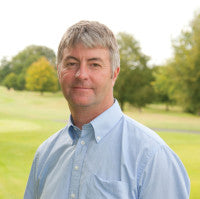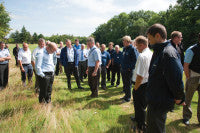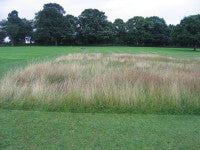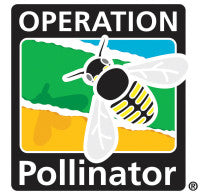Syngenta's Operation Pollinator creating a buzz with greenkeepers
 "The key aim is to target areas of low ecological value, and transform them into habitats that can support a diverse array of plants, insects and other species"
"The key aim is to target areas of low ecological value, and transform them into habitats that can support a diverse array of plants, insects and other species"
Bob Taylor, STRI Ecology & Environment Manager
The Operation Pollinator project is now live and running, with the target of establishing 250 hectares of new ecological habitat specifically designed to encourage bumblebees and other pollinating insects, as well as providing an attractive interest point for golf courses and players. Golf clubs are invited to sign up for the initiative by registering online.
At the workshops, STRI Ecology & Environment Manager, Bob Taylor, reported Operation Pollinator trials at STRI in Yorkshire have, over the past three years, created a wildflower habitat of quite stunning diversity that has been alive with bumblebees and pollinating insects, as well as season-long visual colour. The techniques developed by the project, including integrating chemical controls of Rescue and Primo Maxx, in conjunction with conventional cutting and scarifying, now offer greenkeepers a faster and potentially more effective route to successfully establish wildflowers.
 Bob urged greenkeepers to assess suitable areas for Operation Pollinator habitat establishment, within the wider context of the club's environmental initiatives and as part of the whole course set-up and management. "The key aim is to target areas of low ecological value, and transform them into habitats that can support a diverse array of plants, insects and other species. We don't want to replace naturally occurring valuable habitat areas, but supplement existing initiatives with further environmental assets." He highlighted that clubs with SSSI management agreements should consult with their statutory authorities before proceeding.
Bob urged greenkeepers to assess suitable areas for Operation Pollinator habitat establishment, within the wider context of the club's environmental initiatives and as part of the whole course set-up and management. "The key aim is to target areas of low ecological value, and transform them into habitats that can support a diverse array of plants, insects and other species. We don't want to replace naturally occurring valuable habitat areas, but supplement existing initiatives with further environmental assets." He highlighted that clubs with SSSI management agreements should consult with their statutory authorities before proceeding.
Careful assessment of potential areas is required to identify existing flora and fauna before cutting back. It will also identify any need for Rescue herbicide treatment to remove coarse grasses, including Ryegrass and Yorkshire Fog, to create a more open grass sward where wildflowers can flourish.
Whilst the pilot phase of Operation Pollinator is initially seeking to get golf courses to establish relatively small 0.5 hectare areas, to gain greater experience, Bob believes there is wider potential to increase the connectivity between environmental features on the course, which could hugely increase their ecological value for a wider range of species. 
"We need to be thinking more creatively about managing in-play areas to optimise the golfers' game but, outside that intensively managed course, we have a large area of great ecological potential that can be used to enhance the look and playability of the course, as well as enliven the overall experience and enjoyment players get from their round. There is also the chance to use the environmental work as a marketing edge to attract players to the club."
He stressed the need to provide a mixture of flowering plants and grasses that give the necessary habitats for pollinating insects to feed and breed successfully; understanding the life cycle of the insects we are aiming to attract will help ensure we are creating appropriate resources. The seed mixtures are specifically designed to give season-long food sources for bees, but will also attract and support butterflies and other pollinating insects, which in turn develop the food web, advised Bob.
 "The long flowering period means they look good through the season and are constantly changing to give a different visual aspect for golfers. The mixtures have also been selected as being relatively easy to establish and sufficiently robust to manage in a golf course scenario."
"The long flowering period means they look good through the season and are constantly changing to give a different visual aspect for golfers. The mixtures have also been selected as being relatively easy to establish and sufficiently robust to manage in a golf course scenario."
In addition, the established practices of removing dominant grass species and scarifying the surface will encourage native wildflowers from the natural seedbank. "As areas develop, it may even be possible to harvest your own seed from pollen and nectar areas, and use that for the cost-effective establishment of new areas that will further increase the value of the project," he added.
Bob highlighted that it's not all about flowers; you need the right balance with grass species to provide a mixed habitat of breeding and feeding sites for pollinators and other insects. Typically, the fine grasses are more ecologically valuable, where the combination of cutting and removal with the use of selective herbicide can help to maintain the right balance.
 He also suggested greenkeepers should not be too tidy in areas designated for ecological management. Bramble needs to be cut back in playing areas, for example, but in woodland areas, the plants are a really important wildlife asset. Log piles, and especially standing dead timber, is also extremely valuable - but you need to consider connectivity of these features and linking them together; for a 3mm beetle, a 10 metre expanse of bare earth may be too much to bridge without help.
He also suggested greenkeepers should not be too tidy in areas designated for ecological management. Bramble needs to be cut back in playing areas, for example, but in woodland areas, the plants are a really important wildlife asset. Log piles, and especially standing dead timber, is also extremely valuable - but you need to consider connectivity of these features and linking them together; for a 3mm beetle, a 10 metre expanse of bare earth may be too much to bridge without help.
Establishing a strip of habitat alongside a water course, for example, will not only provide a valuable extra ecological resource, but can have a positive benefit for golfers by stopping balls rolling into the water. It also adds an additional interesting feature to the course, and creates a natural buffer that can simplify management of fairways and greens. "It's an example of how we can integrate the management of ecological features with the management of the golf course, for the benefit of the environment and the golfing experience," he added.
Operation Pollinator trials
 Trials at STRI have determined the optimal management programmes to reduce undesirable grass species and encourage wildflowers. Where plots were just simply cut and scarified to 40-60% bare ground, the thick Ryegrass and Yorkshire Fog quickly recovered. The mechanical techniques proved insufficient to suppress vigorous grass growth or allow wildflowers to establish.
Trials at STRI have determined the optimal management programmes to reduce undesirable grass species and encourage wildflowers. Where plots were just simply cut and scarified to 40-60% bare ground, the thick Ryegrass and Yorkshire Fog quickly recovered. The mechanical techniques proved insufficient to suppress vigorous grass growth or allow wildflowers to establish.
The use of Primo Maxx before sowing wildflower seed did help to reduce competition from the existing turf and enabled wildflowers to establish more effectively, but by far the best results were achieved by an autumn programme of:
- cut and remove existing vegetation
- allow some regrowth to recover and then spray with Rescue
- leave for three weeks and then scarify the surface aggressively
- spray with Primo Maxx
- overseed with wildflower mixture five days later
 Over the past three years, the plots treated with both Rescue and Primo Maxx has seen the Bent, Fescue and Sweet Vernal Grass dominate, whilst the wildflowers have established successfully and become more prolific every year. "It's now really good, with lots of wildflowers providing a long season of pollen and nectar and great interest, whilst the grasses are still there to create the diversity and maintain the necessary look and feel of a golf course," said Bob.
Over the past three years, the plots treated with both Rescue and Primo Maxx has seen the Bent, Fescue and Sweet Vernal Grass dominate, whilst the wildflowers have established successfully and become more prolific every year. "It's now really good, with lots of wildflowers providing a long season of pollen and nectar and great interest, whilst the grasses are still there to create the diversity and maintain the necessary look and feel of a golf course," said Bob.
"We know that repeated cutting and scarification will, over time, improve the quality of the sward for playability. In some situations, however, it may be achieved in one or two seasons with Rescue use in problematic areas where rough grasses are dominant. As an integrated approach, it's an exciting opportunity for ecological management."
Project aims
The project aims to establish over 250 hectares of new Operation Pollinator habitat at up to 500 golf clubs across the UK over the next three years - providing an important ecological resource for bumblebees and other pollinating insects. For more information, and to get involved, greenkeepers and club managers can sign up for Operation Pollinator at www.greencast.co.uk or visit www.operationpollinator.com/golf
The delegates' opinions
 To everyone at Syngenta, the workshop I attended yesterday at Elmwood was fantastic and certainly gave me more incentive to promote wildflowers and pollinating insects. I am hoping to get the ball rolling, probably later in the year. Bob Taylor certainly knows his stuff. Some people may be put off thinking it's just another sales pitch; it certainly is not. When I was cutting the greens this morning, I paid more attention to our rough areas, and the wildflowers in them, sometimes you take things for granted. I will keep in touch with you and let you know when I am ready to proceed. Thanks again.
To everyone at Syngenta, the workshop I attended yesterday at Elmwood was fantastic and certainly gave me more incentive to promote wildflowers and pollinating insects. I am hoping to get the ball rolling, probably later in the year. Bob Taylor certainly knows his stuff. Some people may be put off thinking it's just another sales pitch; it certainly is not. When I was cutting the greens this morning, I paid more attention to our rough areas, and the wildflowers in them, sometimes you take things for granted. I will keep in touch with you and let you know when I am ready to proceed. Thanks again.
Peter Baume, Magdalene Fields Golf Club
"Thanks for the seminar today, it was thoroughly enjoyable and informative. The presentations from Bob Taylor and Simon Watson were excellent. Many thanks."
Terry Wharton, Head Greenkeeper, Haydock Park Golf Club
"The workshop was fantastic with terrific energy from both Simon and Bob Taylor. Peter Todd also put in a significant contribution with his wealth of site knowledge. Thanks again for arranging and supporting the day and the initiative. We will certainly be signing up and already have some plans as to how we plot out the site. Thanks again and best wishes."
Paul Worster, Golf Courses Manager, Minchinhampton Golf Club
